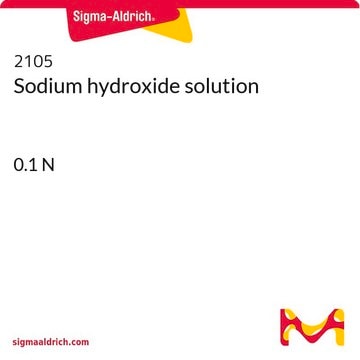43617
Sodium hydroxide solution
0.1 M NaOH in water (0.1N), Eluent concentrate for IC
Synonym(s):
Sodium hydroxide solution
About This Item
Recommended Products
product name
Sodium hydroxide concentrate, 0.1 M NaOH in water (0.1N), Eluent concentrate for IC
agency
suitable for SM 4500 - NH3
Quality Level
vapor pressure
3 mmHg ( 37 °C)
form
liquid
concentration
0.1 M NaOH in water (0.1N)
technique(s)
ion chromatography: suitable
SMILES string
[OH-].[Na+]
InChI
1S/Na.H2O/h;1H2/q+1;/p-1
InChI key
HEMHJVSKTPXQMS-UHFFFAOYSA-M
Looking for similar products? Visit Product Comparison Guide
General description
Application
Linkage
Preparation Note
related product
signalword
Warning
hcodes
pcodes
Hazard Classifications
Met. Corr. 1
Storage Class
8B - Non-combustible corrosive hazardous materials
wgk_germany
nwg
flash_point_f
Not applicable
flash_point_c
Not applicable
ppe
Eyeshields, Gloves
Choose from one of the most recent versions:
Already Own This Product?
Find documentation for the products that you have recently purchased in the Document Library.
Customers Also Viewed
Related Content
This page is intended to make it easier to find the consumables you need based on the analytical method you’re using. Methods included on this page come from the EPA, Standard Methods and ASTM.
Our team of scientists has experience in all areas of research including Life Science, Material Science, Chemical Synthesis, Chromatography, Analytical and many others.
Contact Technical Service

